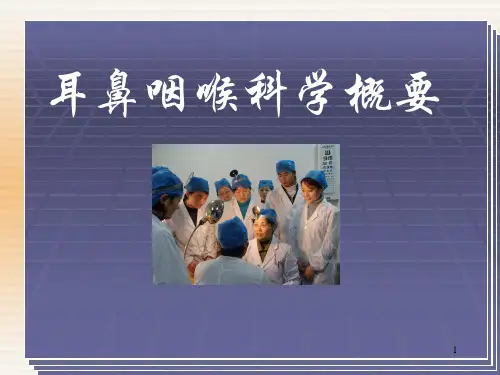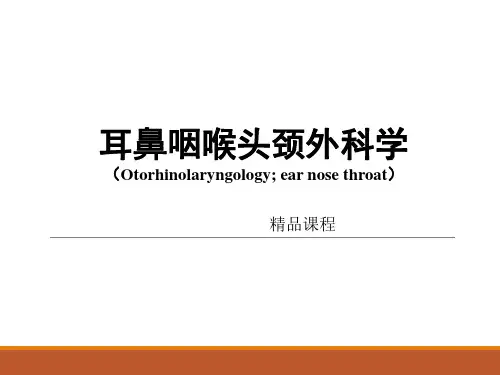- 1、下载文档前请自行甄别文档内容的完整性,平台不提供额外的编辑、内容补充、找答案等附加服务。
- 2、"仅部分预览"的文档,不可在线预览部分如存在完整性等问题,可反馈申请退款(可完整预览的文档不适用该条件!)。
- 3、如文档侵犯您的权益,请联系客服反馈,我们会尽快为您处理(人工客服工作时间:9:00-18:30)。
Image study
CT can characterize the extent of the otosclerotic focus at the oval window
CT scan can exclude capsular involvement when patients have significant mixed hearing loss
The early phase is characterized by multiple active cell groups including osteocytes, osteoblasts, and histiocytes. It develops a spongy appearance because of vascular dilation secondary to osteocyte resorption of bone surrounding blood vessels. This can be seen grossly as red hue behind the tympanic membrane termed “Schwartze's sign”
Epidemiology
Race
incidence of microscopic otosclerosis
Caucasian
10%
Asian
5%
African American
1%
Native American
0%
Etiology
Many theories have been proposed such as
Paracusis of Willis.
It occurs because the CHL reduces the volume of the back ground noise,
Two-thirds of patients will report a family history of hearing loss.
diagnosis of otosclerosis less likely. 25% of patients present with some vestibular
complaints
Diagnosis
low-volume speech.
conductive nature of their hearing loss, they perceive there voice as louder than it actually is.
Women with pregnancy worse her hearing
Physical examination
TM appears normal in the majority of patients Schwartze sign is observed in 10% of patients). Rinne test: negative
Otosclerosis
Chunfu Dai Otolaryngology Department
Fudan University
Background
Definition
primary metabolic bone disease of the otic capsule and ossicles
It causes fixation of the ossicles (stapes) It results in conductive or mixed hearing loss. It is genetically-mediated via autosomal
dominant transmission
Early in the disease, low frequency CHL will predominate resulting in a negative Rinne test with the 256-Hz only.
As progression occurs, the 512 and then the 1,024-Hz TF will become negative.
If only the footplate is involved, it is sometimes referred to as a “stapedial otosclerosis”.
When the entire footplate and annular ligament are involved it is known as an obliterated footplate or obliterative otosclerosis.
Tests
Pure tone audiometry
Early stage: a decrease in air conduction in the low frequency, especially below 1000 Hz.
As the disease progresses, the air line flattens. because the otosclerotic focus has a mass affect on the entire system, carhart notch is noted.
Further progression of otosclerosis to involve the cochlea may result in increased bone conduction thresholds in high frequency, A-B gap exists in low frequency.
Carhart notch is the
hallmark audiologic sign of otosclerosis.
It is characterized by a decreased in the bone conduction thresholds of approximately 5 dB at 500 Hz, 10 dB at 1000 Hz, 15 dB at 2000 Hz, and 5 dB at 4000 Hz.
An enlarged cochlear aqueduct may be seen which potential causes perilymph gusher during footplate fenestration or removal.
Pathophysiology
The most common site of involvement is the anterior oval window near the fistula ante fenestrum.
When both the anterior and posterior ends of the footplate are involved it is termed “bipolar” involvement or fixation (if the footplate is immobile).
Weber test: laterization to poor HL Schwabach test: prolonged bone conduction Gelle test: negative
type As (s-stiffness curve) tympanogram and is characteristic of advanced otosclerosis but more commonly, malleus fixation.
hereditary, 54% of patients present with family history endocrine, women with pregnancy worse her hearing metabolic, enzyme abnormal was pathogen infectious, virus was identified in the lesion vascular, autoimmune,
Diagnosis
Slowly progressive, bilateral (80%), asymmetric, conductive hearing loss
Tinnitus is associated with 75% patients The age of onset of hearing loss is young History of significant ear infections makes the
Pathophysiology
Microscopically, a focus of active otosclerosis reveals finger projections of disorganized bone, rich in osteocytes particularly at the leading edge. In the center of the focus, multinucleated osteocytes are often present. In the sclerotic phase,
The round window is involved in approximately 30% to 50% of cases
Pathophysiology
otosclerosis has two main forms:
an early of spongiotic phase (otospongiosis)
Pathophysiology
Otosclerosis (otospongiosis) is an osseous dyscrasia, limited to the temporal bone, and characterized by resorption and formation of new bone in the area of the ossicles and otic capsule.







